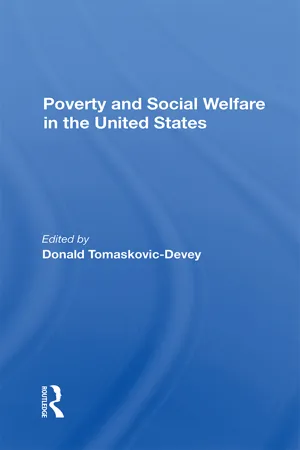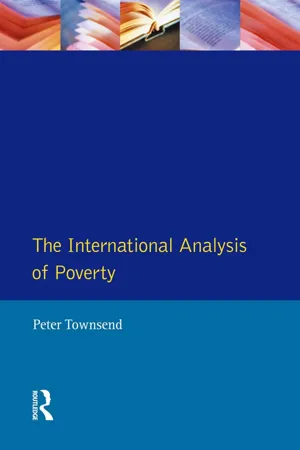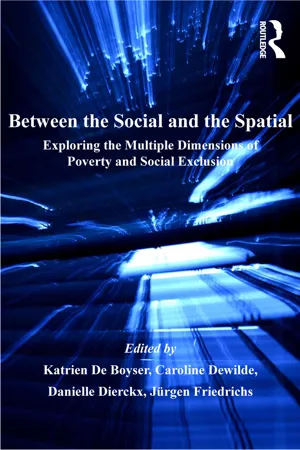Social Sciences
Poverty in the US
Poverty in the US refers to the condition of lacking the financial resources and basic necessities required for a standard of living considered acceptable in society. It is often measured by income levels and can have wide-ranging social and economic implications. Factors such as education, employment opportunities, and access to healthcare play significant roles in perpetuating or alleviating poverty.
Written by Perlego with AI-assistance
Related key terms
6 Key excerpts on "Poverty in the US"
- eBook - ePub
- Donald Tomaskovic-devey(Author)
- 2019(Publication Date)
- Routledge(Publisher)
If we want to understand poverty then it should be as a social condition, characterized by isolation from participation in the culture. The poor are isolated primarily because their low level of material resources, makes normal social activity difficult at best. In the United States money is the key to social participation, people with little access to money spend everything they have on survival with little to spare for visiting friends, relatives and churches, much less in long term investments in education, travel to distant work places or the acquisition of stable job histories. Social isolation does not imply, however, physical isolation from other people. The poor often work in paid jobs and form communities of their own. It is not total isolation from others that creates this social notion of poverty but rather the limited character of social participation.Defining PovertyThe preceding discussion leads to a simple definition of poverty. The poor are those people whose income is below the level needed for normal social participation. People whose income is below this level will tend to be both materially deprived and socially isolated, which may lead to low levels of self-esteem and the potential for anti-social behavior.This social definition of poverty is helpful in understanding the individual and social consequences of poverty. It is not, however, the definition of poverty commonly used in empirical studies of U.S. poverty, including those in this book, nor in the creation of social policies to deal with the poor. The definition of poverty in U.S. policy and research focuses not on relative but on absolute material deprivation in the population. The U.S. poverty line is, in fact, a nutritional baseline for physical survival. It was originally computed in the early sixties as three times the cost of an emergency economy food plan (Orshansky, 1965). The food plan covered the bare minimum of caloric intake for short term survival if the shopper was careful to buy only the cheapest foods with the highest nutritional payoff (e.g. rice and beans; milk and potatoes). The plan was multiplied by three on the assumption that about one-third of the typical American household income went to buy food. This nutritional survival definition remains the definition of U.S. poverty, it has been adjusted since its inception in 1964 only for inflation and how it treats farm families.Does this mean that the 31 million people who are officially below the poverty line in the United States are slowly starving to death? In general it does not, although of course many are hungry at some time. The poor actually spend more than a third of their income on food and so the official definition understates the nutritional threat of being officially poor. In addition, while the social definition of poverty implies social isolation, this isolation is relative rather than absolute and the poor are often aided with gifts of food and services from friends, relatives and occasionally public and private agencies. These in-kind transfers are not counted as income even though they clearly act to support those who are poor. From this point of view, the current poverty line can be best understood as a minimal and harsh standard of living. While a literal nutritional interpretation of the poverty line probably overstates the amount of hunger and physical deterioration associated with poverty, the poor in the United States are likely to be hungry regularly (when money runs out or when in-kind transfers from relatives or friends are unavailable) and the physical health of the poor is lower than that of the rest of the population. The poor die younger, spend more time sick in bed, and are much more likely to give birth to babies who will die in the first year of life. See the extensive bibliography in Chalfant (1985) and the Arendell (Chapter 3 ) and Sarri and Russell (Chapter 9 - eBook - ePub
- Peter Townsend(Author)
- 2014(Publication Date)
- Routledge(Publisher)
Chapter 4 , below).Poverty may best be understood as applying not just to those who are victims of a maldistribution of resources but, more exactly, to those whose resources do not allow them to fulfil the elaborate social demands and customs which have been placed upon citizens of that society: they are materially and socially deprived in a variety of ways which can be observed, described and measured. A relationship between empirical evidence and the development of theory can be properly established. The links between social structure and especially between social class and income can be investigated and demonstrated at the heart of any generalisations about ‘the social condition’.The Definition of Poverty
The driving motivation for putting forward poverty as ‘relative deprivation’ could be said to be scientific and international. There are respects in which the ‘subsistence’ concept minimises the range and depth of human need just as the ‘basic needs’ concept is restricted primarily to the physical facilities of the communities of the Third World.People are relatively deprived if they cannot obtain, at all or sufficiently, the conditions of life — that is, the diets, amenities, standards and services — which allow them to play the roles, participate in the relationships and follow the customary behaviour which is expected of them by virtue of their membership of society. If they lack or are denied resources to obtain access to these conditions of life and so fulfil membership of society they may be said to be in poverty. People may be deprived in any or all of the major spheres of life — at work where the means largely determining position in other spheres are earned; at home, in neighbourhood and family; in travel; in a range of social and individual activities outside work and home or neighbourhood in performing a variety of roles in fulfilment of social obligations. - eBook - ePub
The Geography of United States Poverty
Patterns of Deprivation, 1980-1990
- Wendy Shaw(Author)
- 2015(Publication Date)
- Routledge(Publisher)
III United States Poverty and Its Definition and Measurement BACKGROUND Historical Poverty LevelsPoverty is a persistent problem within the United States (Anon 1989; Rubinstein 1989; Ropers 1991) and, as both Peet (1972) and Plotnick (1975) comment, absolute poverty due to insufficient nutrition still exists within the nation. Hunger, as evidenced by breadlines, is faced by some citizens everyday within the general affluence of the United States (Kodras 1992). Despite overall affluence in terms of both resources and wealth, the achievement of such affluence has persistently eluded a significant segment of American society (Burton 1992). Herbert Hoover’s optimistic proclamation, made in 1928, that the day was “in sight” when poverty would be “banished in this nation” has proven to be far from reality some sixty five years later. This failure to banish poverty comes despite public awareness of the problem and the “War on Poverty” declared by President Lyndon B. Johnson in 1964.There has been considerable progress toward eradicating absolute poverty such as is relatively common in some of the world’s poorest countries. Absolute poverty is manifest in such things as severe malnutrition and lack of basic resources needed to sustain life. However, little progress has been made in addressing relative poverty. Relative poverty is defined by the values, norms, and general level of affluence of society, and people are considered poor when they fail to live at some generally accepted standard (Quibria 1991). Relative poverty is still widespread; moreover, it is only the growth of transfer payments that has prevented an increase (Smolensky 1981–82; Greenstein 1985). Since the political leadership in the 1980s with its ideological opposition to welfare curtailed many transfer payments, poverty is once more affecting increasing numbers of Americans (Dobelstein 1987; Tootle 1989). Moreover, it can be convincingly argued that many who live above the official poverty level experience extreme deprivation; thus the number of poor Americans may be even larger than official statistics suggest. - eBook - ePub
- Erich Goode(Author)
- 2022(Publication Date)
- Routledge(Publisher)
Poverty is both relative and absolute, and it is relative to within-society comparisons as well as from one society to another; it is absolute with respect to its relationship to disease and mortality—that is, virtually everywhere, the poor get sick more and die younger than the affluent, but they do so more so in some societies than in others. The UN’s figures indicate that the most equitably distributed economies are the nations in Scandinavia (Denmark, Sweden, and Norway)—small, affluent, democratic, European countries with high taxes, abundant social services, and very few poor people. The least equitable societies are those in poor, Third World countries, mainly in Africa, Latin America, and the Caribbean (Honduras, Guatemala, Brazil, Panama, Haiti), with unstable, relatively poorly performing economies, insufficient social services, and a comparatively high proportion of poor people. The distribution of the economy of the United States is somewhere in between these two extremes, at least with respect to the distribution of its resources. Since antiquity, numerous philosophers and theologians have speculated and commented on poverty from a variety of perspectives. Proverbs (14:31) declared, “He who oppresses the poor shows contempt for his Maker, but whoever is kind to the needy honors God.” In his Politics, Aristotle (384–322 BCE) wisely argued that “poverty is the parent of revolution and crime.” In Satires, Juvenal (first to second century CE) opined that “It is not easy for men to rise whose qualities are thwarted by poverty.” More recent statements by theorists and social scientists have added depth and complexity to these ancient assertions - eBook - ePub
Economic Inequality and Poverty: International Perspectives
International Perspectives
- Lars Osberg(Author)
- 2017(Publication Date)
- Routledge(Publisher)
Summarizing, although welfare is theoretically the best basis for a poverty line definition, in practice both the measurement problems and the essentially subjective nature of welfare cause a new set of problems. To some extent, however, these latter problems are implicitly present in all poverty line definitions, and only made more explicit in poverty line definitions aiming to be a proxy for welfare. Human behavior, as well as the evaluation of one's situation in terms of welfare or utility, varies because of many reasons, not only because of differences in command over resources. Which of these reasons should be considered relevant for the purpose of a poverty definition? However this question is answered, every selection will result in a difference between the population of poor according to the criteria chosen and the population of poor according to their subjective welfare. In order to analyze this difference, it is therefore always advisable to obtain information on both subjective evaluations and objective conditions of households.1.4. Does the Choice of Definition Matter?
In the paragraphs above the advantages and disadvantages of a number of poverty definitions are discussed. If, however, the differences between these poverty definitions in practical research are relatively small, this discussion would be only of theoretical value, without much relevance for poverty research or policy. In this section I will therefore review empirical studies in which the composition and size of the population of poor is compared, using different definitions of poverty.The relevance of the choice of money income versus a more comprehensive measure of economic status is demonstrated in work by Garfinkel and Haveman (1977a, 1977b). They compare the composition of the population of poor (both households and individuals) based on the current income poverty line to the composition of the poor based on their index of "earnings capacity."According to the current income poverty line, households in which the main breadwinner is black, full-time working, and has a low level of education are underrepresented, as are large families. Older people and farmers, on the other hand, are overrepresented in the population of poor according to the current income poverty line. - eBook - ePub
Between the Social and the Spatial
Exploring the Multiple Dimensions of Poverty and Social Exclusion
- Katrien De Boyser, Jürgen Friedrichs, Caroline Dewilde(Authors)
- 2016(Publication Date)
- Routledge(Publisher)
sui generis , separate from the individual elements that characterise it. In other words, every elementary form of poverty corresponds to a state of equilibrium consisting of relatively crystallised relations between unequal individuals (poor people and non-poor people) at the heart of the social system.1 Cf. Le rapport de l’Observatoire national de la pauvreté et de l’exclusion sociale 2003-2004, Paris, La documentation française, 2004, p. 18 onwards.2 Ibid., p. 803.3 Source: Eurostat, 2001.4 This expression refers to the three decades (1945-1975) following the Second World War, characterised by strong economic growth and welfare state expansion.Passage contains an image
Chapter 2Income, Health and Multi-dimensionality1
A.B. Atkinson1. Beyond Income
One of the most significant moves in the measurement of poverty and inequality has been that from a single-dimensioned focus on income or consumption to a concern with multi-dimensioned measures of well-being. In this advance towards a broader understanding, Jan Vranken has been in the vanguard. To quote from the report which he orchestrated, Towards a Policy Relevant European Database on Forms of Social Exclusion, theversion of poverty as lack of resources is challenged by a broader multidimensional approach … Poverty is more and more seen as an accumulation of problems … Poverty has to do with a limited participation in various social commodities such as income, labour, education, health, administration of justice, collective provisions and culture. A person is categorised as poor on the basis of an accumulation of situations of exclusion on different domains. (Vranken, De Keulenaer et al. 2001)As has been demonstrated in multidimensional studies of poverty and inequality, taking account of non-income domains can radically affect the conclusions drawn. For instance, in his study of France, Germany, Italy and the United Kingdom, Brandolini (2008) shows how broadening the evaluative space to include health status in addition to income can change the relative ranking of the degree of deprivation in the four countries.
Learn about this page
Index pages curate the most relevant extracts from our library of academic textbooks. They’ve been created using an in-house natural language model (NLM), each adding context and meaning to key research topics.




